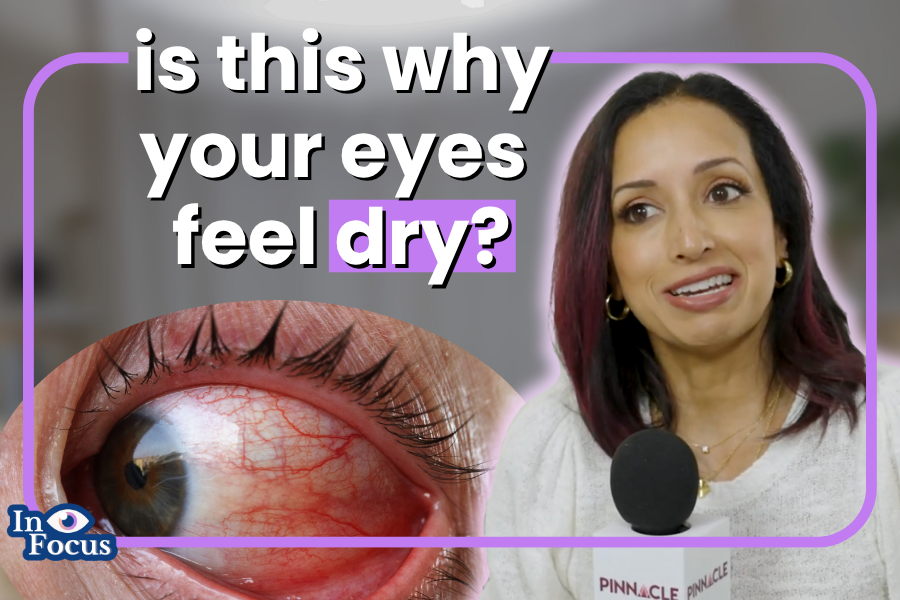Is Your Makeup Causing Your Dry Eye?
Listen On
A 38-year-old woman came into my clinic recently with eyes that were red, irritated, and constantly dry.
She was using artificial tears every two hours, taking omega-3 supplements, and doing “everything right.”
But nothing helped.
When I examined her eyes, two things stood out immediately:
she was tight-lining her eyeliner directly on the waterline, and her moisturizer and eye cream both contained retinol.
That combination was the perfect storm for her tear film.
Once we changed her routine, her eyes began to heal.
As an ophthalmologist — and a makeup-loving woman myself — I get it. Eye makeup is fun. It helps us feel polished, expressive, even confident. But it can also quietly damage the tiny glands that keep our eyes comfortable.
Let’s talk about why.
What Makes Eyes Feel “Dry”?
Our eyes aren’t actually supposed to feel anything. They should feel invisible — comfortable, effortless, clear.
That’s thanks to a delicate tear film that coats the front of the eye. It’s made up of three parts:
Oil (lipid layer): made by the meibomian glands in your eyelids; it keeps tears from evaporating.
Water (aqueous layer): the actual tears we produce.
Mucus layer: spreads tears evenly across the eye.
When the oily layer breaks down, tears evaporate too quickly — and that’s what we call evaporative dry eye.
Cosmetics are a major and often overlooked cause.
The #1 Offender: Tightlining the Waterline
Tightlining (lining your inner rim, the pink part) is one of the worst things you can do for your meibomian glands.
Here’s why:
Those glands open right onto that rim.
Waterproof eyeliners clog them easily.
Once clogged, the oil can’t reach your tear film, and your eyes dry out.
I’ll be honest: I tightline occasionally for special events or filming. But daily? No.
If you’re already dealing with dryness, stop immediately. You’ll likely feel the difference in a week.
Ingredients to Watch Out For
When you’re scanning your product labels, keep an eye out (pun intended) for these common culprits:
1. BAK (benzalkonium chloride)
A preservative found in many eye drops and makeup products. It’s known to inflame or even damage the meibomian glands in some people.
2. Formaldehyde or formaldehyde-releasing adhesives
Common in lash glues and certain mascaras. Chronic exposure can be toxic to the glands that produce your eye’s natural oils.
3. Retinol
Yes — the beloved anti-aging ingredient. When applied too close to the lash line, it can actually cause gland dropout (permanent loss of those oil-producing glands).
Keep retinol outside the bony eye socket, never on the eyelid itself, and use only a pea-sized amount.
4. PFAS (per- and poly-fluoroalkyl substances)
These “forever chemicals” show up in some cosmetics and can cause surface irritation.
5. Glitter & fiber mascaras
Loose glitter or lengthening fibers can flake into the eye and physically block the glands.
If you love dramatic lashes, try a tubing mascara instead — it forms tiny water-soluble tubes around each lash and removes easily with warm water.
The Right Way to Remove Eye Makeup
Good hygiene is everything.
Sleeping in makeup can trigger inflammation, infection, and even Demodex (lash mites) — tiny organisms that thrive in mascara buildup and block your glands further.
Here’s the ideal nightly routine:
Use a gentle, oil-based remover to dissolve makeup.
Follow with a mild water-based cleanser for your face.
Avoid harsh rubbing — the eyelid skin is the thinnest on your body.
Skip waterproof formulas unless absolutely necessary — they require harsher removers.
If you wear contact lenses, always remove them before cleansing.
How to Heal Your Eyes
The good news: with care and consistency, you can reverse a lot of the inflammation caused by makeup habits.
Start by:
Avoiding tightlining and heavy waterproof products.
Moving retinol away from the lid margins.
Using warm compresses for 8–10 minutes daily to melt and release gland oils.
Asking your eye doctor for a meibomian gland evaluation if dryness persists.
For chronic cases, treatments like IPL (Intense Pulsed Light) or LipiFlow can gently open and restore gland function. Omega-3 supplements may also help, especially when used consistently.
For Parents of Makeup-Loving Tweens
As more young teens experiment with cosmetics, it’s important they learn healthy habits early:
No sleeping in eye makeup.
No liner on the waterline.
Always remove everything before bed.
Meibomian gland dysfunction is now one of the most common causes of dry eye in adolescents — something we didn’t see as much a decade ago. Starting good habits young matters.
The Bottom Line
Makeup doesn’t have to mean misery for your eyes.
It just takes awareness — about ingredients, placement, and hygiene.
So the next time your eyes feel gritty or tired, take a look at your vanity table.
Sometimes the answer isn’t more eye drops… it’s less eyeliner.
Want to Learn More?
This is just the beginning. In upcoming episodes, we’ll explore:
-How screen time and digital habits are shaping our kids’ development
–The connection between vision and overall health
–What you need to know about common eye procedures like LASIK and cataract surgery
–Practical ways to advocate for your child’s visual needs
You can subscribe to my podcast, In Focus, anywhere you listen—or follow along on Instagram for updates and tips.
Watch this episode on Youtube right now!
Thanks for reading—and for doing what you can to protect your child’s vision, one step at a time.
– Dr. Rupa Wong
Pediatric Ophthalmologist | Surgeon | Mom of 3
This episode is brought to you by The Pinnacle Podcast Network! Learn more about Pinnacle at learnatpinnacle.com



